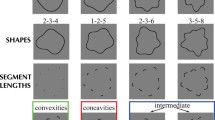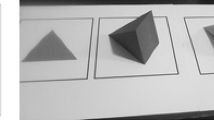Abstract
Children aged between 4 years and 6 months and 11 years and 10 months were individually administered a series of spatial Tasks involving the conceptualisation and manipulation of an unfamiliar plane shape. An analysis of the children's performance revealed that both initial perception of a shape and approach to task solution strongly influence children's success at shape recognition. The findings also suggest that both visual perception limitations, together with an unwillingness to experiment visually and physically, lead to shape recognition difficulties.
Similar content being viewed by others
References
Braine, L., Lerner, C., and Relyea, L.: 1980, Levels in the identifying of orientation by preschool children,Journal of Experimental Child Psychology 30(1), 171–185.
Chancellor, D.: 1991, Higher-order thinking: a ‘basic skill for everyone’,Arithmetic Teacher 38, 48–50.
Fisher, D.: 1983, Some perceptual influences in learning geometry, in ‘Proceedings of the Seventh Annual Meeting of the International Group for the Psychology of Mathematics Education, pp. 217–222.
Glaser, R.: 1984, Education and thinking — The role of knowledge,American Psychologist 39(2), 93–104.
Hershkowitz, R.: 1989, Visualisation in geometry — two sides of the coin,Focus on Learning Problems in Mathematics, 11(1), 61–75.
Hoz, R.: 1981, The effects of rigidity on school geometry learning,Educational Studies in Mathematics, 12, 171–190.
Krutetskii, V. A.: 1976,The psychology of mathematical abilities in school children, University of Chicago Press, Chicago.
Lakoff, G.: 1985,Women, fire and dangerous things, University of Chicago Press, Chicago.
Lesh, R., and Mierkiewicz, D.: 1978, Perception, imagery and conception in geometry,Recent research concerning the development of spatial concepts, Centre for Science and Mathematics Education ERIC Science, Mathematics and Environmental Education Clearinghouse.
Presmeg, N.: 1986, Visualisation in high school mathematics,For the Learning of Mathematics, 6(3),42–46.
Presmeg, N.: 1992, ‘Prototypes, metaphors, metonymies and imaginative rationality in high school mathematics,Educational Studies in Mathematics, 23, 595–610.
Rosch, E. and Mervis, C.: 1975, Family resemblances: Studies in the internal structure of categories,Cognitive Psychology, 7, 578–605.
Rosch, E.: 1978, Principles of categorization, in E. Rosch and B. Lloyd (eds.),Cognition and categorization, Lawrence Erlbaum Associates, Hillsdale.
Shaugnessy, J, and Burger, W.: 1985, Spadework prior to deduction in geometry,Mathematics Teacher, 18(6), 419–428.
Tarte, L.: 1990, Spatial orientation skill and mathematical problem solving,Journal for Research in Mathematics Education, 21(3), 216–229.
Tall, D., and Vinner, S.: 1981, Concept image and concept definition in mathematics with particular reference to limits and continuity,Educational Studies in Mathematics, 12, 151–169.
Thornton, C., Tucker, B., Dossey, J., and Bazik, E.: 1983.Teaching mathematics to children with special needs, Addison Wesley Pub. Inc, Menlow Park.
Vinner, E.: 1983, Some perceptual influences in learning geometry, inProceedings of the Eighth Annual Meeting of the International Group for the Psychology of Mathematics Education, pp. 217–222.
Williams, E., and Shuard, H.: 1982,Primary mathematics today — for the age of the calculator, Longman Group Limited, London.
Woods, D.: 1989, PS corner: teaching thinking and ideas about assessment,Journal of College Science Teaching, 18(5), 338–340.
Author information
Authors and Affiliations
Rights and permissions
About this article
Cite this article
Warren, E., English, L. Facility with plane shapes: A multifaceted skill. Educ Stud Math 28, 365–383 (1995). https://doi.org/10.1007/BF01274079
Issue Date:
DOI: https://doi.org/10.1007/BF01274079




